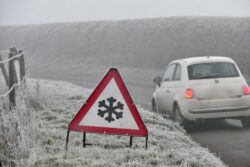Many of us have woken up to freezing fog lately (Picture: Geoffrey Swaine/Shutterstock)
Freezing fog is having a widespread impact this January, causing havoc with travel and sending air pollution levels soaring.
With the Met Office issuing another yellow warning for freezing fog London, the South East and the South West today, further disruption is likely.
Thousands of people faced cancellations at Heathrow earlier this week as more than 80 British Airways flights were grounded due to the weather.
But what is freezing fog and how does it form?
Here’s what you need to know.
How does freezing fog form?
January has seen London and many parts of the UK hit by freezing fog (Picture: George Cracknell Wright)
According to the UK Met Office, freezing fog forms in the same way as normal fog – when the land cools overnight under clear skies.
As it does so, the heat radiates upwards into space, cooling the earth’s surface.
This means that the air is less able to hold moisture, so the water vapour condenses into tiny droplets which eventually form fog – essentially a cloud at ground level.
But if the temperature is below freezing, these droplets become supercooled water and remain as a liquid.
That’s because to become ice, they need to land on something.
And when they do, you get a pretty deposit of feathery ice crystals known as ‘rime’. It’s usually on higher ground and mountains but we’ve seen it in the city this winter.
When freezing fog lands, it leaves feathery ice crystals known as ‘rime’ (Picture: Geoffrey Swaine/Shutterstock)
When does freezing fog form?
In the UK, it’s usually on winter days when we have clear skies, calm winds and the temperature is below freezing.
Just like we’ve had this January.
If you can see more than 1000m it’s called mist. Anything less than that is fog.
Is freezing fog dangerous?
Heathrow Airport faced major disruption caused by freezing fog (Picture:George Cracknell Wright/ Twitter/pilot_nick)
Not in itself. But it can lead to very dangerous travel conditions.
When visibility falls to below 50m, it’s known as dense fog.
The AA has given its top tips on driving in fog:
Use dipped headlights, plus your wipes and de-misters.
Use fog lights when you need to.
Beware of other drivers not using headlights.
Only drive as fast as conditions allow.
Slow down so you can stop in the distance you can see clearly.
Allow three seconds between you and the car in front instead of two.
Check your mirrors before you slow down.
Open your window to listen for traffic at junctions if you can’t see.
Don’t rely on automatic lights – they might not come on in fog.
Don’t tailgate.
Don’t speed up to get away from a vehicle behind you.
The freezing fog has left some picture-perfect scenes around the UK (Picture: James Linsell-Clark/ SWNS)
How much water is in freezing fog?
If you could somehow fill an Olympic-sized swimming pool with fog and then condense it, you’d be left with about 1.25 litres of water!
MORE : Incredibly rare ‘ice disk’ phenomenon spotted by hikers in Scottish Highlands
MORE : Teenager and dog rescued from frozen pond as temperatures plunge
Follow Metro across our social channels, on Facebook, Twitter and Instagram
Share your views in the comments below
It’s getting cold in here.





